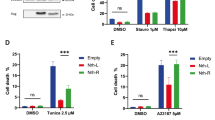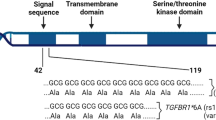Abstract
NQO1 guards against oxidative stress and carcinogenesis and stabilizes p53. We find that a homozygous common missense variant (NQO1*2, rs1800566(T), NM_000903.2:c.558C>T) that disables NQO1 strongly predicts poor survival among two independent series of women with breast cancer (P = 0.002, N = 1,005; P = 0.005, N = 1,162), an effect particularly evident after anthracycline-based adjuvant chemotherapy with epirubicin (P = 7.52 × 10−6) and in p53-aberrant tumors (P = 6.15 × 10−5). Survival after metastasis was reduced among NQO1*2 homozygotes, further implicating NQO1 deficiency in cancer progression and treatment resistance. Consistently, response to epirubicin was impaired in NQO1*2-homozygous breast carcinoma cells in vitro, reflecting both p53-linked and p53-independent roles of NQO1. We propose a model of defective anthracycline response in NQO1-deficient breast tumors, along with increased genomic instability promoted by elevated reactive oxygen species (ROS), and suggest that the NQO1 genotype is a prognostic and predictive marker for breast cancer.
This is a preview of subscription content, access via your institution
Access options
Subscribe to this journal
Receive 12 print issues and online access
$209.00 per year
only $17.42 per issue
Buy this article
- Purchase on Springer Link
- Instant access to full article PDF
Prices may be subject to local taxes which are calculated during checkout





Similar content being viewed by others
Accession codes
References
Goldhirsch, A., Glick, J.H., Gelber, R.D., Coates, A.S. & Senn, H.J. Meeting highlights: International Consensus Panel on the Treatment of Primary Breast Cancer. Seventh International Conference on Adjuvant Therapy of Primary Breast Cancer. J. Clin. Oncol. 19, 3817–3827 (2001).
Pritchard, K.I. et al. HER2 and responsiveness of breast cancer to adjuvant chemotherapy. N. Engl. J. Med. 354, 2103–2111 (2006).
Easton, D.F. et al. Genome-wide association study identifies novel breast cancer susceptibility loci. Nature 447, 1087–1093 (2007).
Tommiska, J. et al. Breast cancer individuals with p53 Pro72 homozygous genotype have a poorer survival. Clin. Cancer Res. 11, 5098–5103 (2005).
Toyama, T. et al. Association of TP53 codon 72 polymorphism and the outcome of adjuvant therapy in breast cancer individuals. Breast Cancer Res. 9, R34 (2007).
Siegel, D. et al. NAD(P)H:quinone oxidoreductase 1: role as a superoxide scavenger. Mol. Pharmacol. 65, 1238–1247 (2004).
Beyer, R.E. et al. The role of DT-diaphorase in the maintenance of the reduced antioxidant form of coenzyme Q in membrane systems. Proc. Natl. Acad. Sci. USA 93, 2528–2532 (1996).
Siegel, D., Bolton, E.M., Burr, J.A., Liebler, D.C. & Ross, D. The reduction of alpha-tocopherolquinone by human NAD(P)H: quinone oxidoreductase: the role of alpha-tocopherolhydroquinone as a cellular antioxidant. Mol. Pharmacol. 52, 300–305 (1997).
Winski, S.L. et al. Relationship between NAD(P)H:quinone oxidoreductase 1 (NQO1) levels in a series of stably transfected cell lines and susceptibility to antitumor quinones. Biochem. Pharmacol. 61, 1509–1516 (2001).
Anwar, A. et al. Interaction of human NAD(P)H:quinone oxidoreductase 1 (NQO1) with the tumor suppressor protein p53 in cells and cell-free systems. J. Biol. Chem. 278, 10368–10373 (2003).
Asher, G., Lotem, J., Cohen, B., Sachs, L. & Shaul, Y. Regulation of p53 stability and p53-dependent apoptosis by NADH quinone oxidoreductase 1. Proc. Natl. Acad. Sci. USA 98, 1188–1193 (2001).
Asher, G., Lotem, J., Kama, R., Sachs, L. & Shaul, Y. NQO1 stabilizes p53 through a distinct pathway. Proc. Natl. Acad. Sci. USA 99, 3099–3104 (2002).
Asher, G., Lotem, J., Sachs, L., Kahana, C. & Shaul, Y. Mdm-2 and ubiquitin-independent p53 proteasomal degradation regulated by NQO1. Proc. Natl. Acad. Sci. USA 99, 13125–13130 (2002).
Iskander, K. et al. Lower induction of p53 and decreased apoptosis in NQO1-null mice lead to increased sensitivity to chemical-induced skin carcinogenesis. Cancer Res. 65, 2054–2058 (2005).
Long, D.J. II et al. NAD(P)H:quinone oxidoreductase 1 deficiency increases susceptibility to benzo(a)pyrene-induced mouse skin carcinogenesis. Cancer Res. 60, 5913–5915 (2000).
Ahn, K.S., Sethi, G., Jain, A.K., Jaiswal, A.K. & Aggarwal, B.B. Genetic deletion of NAD(P)H:quinone oxidoreductase 1 abrogates activation of nuclear factor-kappaB, IkappaBalpha kinase, c-Jun N-terminal kinase, Akt, p38, and p44/42 mitogen-activated protein kinases and potentiates apoptosis. J. Biol. Chem. 281, 19798–19808 (2006).
Kelsey, K.T. et al. Ethnic variation in the prevalence of a common NAD(P)H quinone oxidoreductase polymorphism and its implications for anti-cancer chemotherapy. Br. J. Cancer 76, 852–854 (1997).
Nioi, P. & Hayes, J.D. Contribution of NAD(P)H:quinone oxidoreductase 1 to protection against carcinogenesis, and regulation of its gene by the Nrf2 basic-region leucine zipper and the arylhydrocarbon receptor basic helix-loop-helix transcription factors. Mutat. Res. 555, 149–171 (2004).
Siegel, D. et al. Rapid polyubiquitination and proteasomal degradation of a mutant form of NAD(P)H:quinone oxidoreductase 1. Mol. Pharmacol. 59, 263–268 (2001).
Siegel, D., McGuinness, S.M., Winski, S.L. & Ross, D. Genotype-phenotype relationships in studies of a polymorphism in NAD(P)H:quinone oxidoreductase 1. Pharmacogenetics 9, 113–121 (1999).
Garte, S. et al. Biomarkers of exposure and effect in Bulgarian petrochemical workers exposed to benzene. Chem. Biol. Interact. 153–154, 247–251 (2005).
Rothman, N. et al. Benzene poisoning, a risk factor for hematological malignancy, is associated with the NQO1 609C → T mutation and rapid fractional excretion of chlorzoxazone. Cancer Res. 57, 2839–2842 (1997).
Krajinovic, M., Sinnett, H., Richer, C., Labuda, D. & Sinnett, D. Role of NQO1, MPO and CYP2E1 genetic polymorphisms in the susceptibility to childhood acute lymphoblastic leukemia. Int. J. Cancer 97, 230–236 (2002).
Larson, R.A. et al. Prevalence of the inactivating 609C → T polymorphism in the NAD(P)H:quinone oxidoreductase (NQO1) gene in individuals with primary and therapy-related myeloid leukemia. Blood 94, 803–807 (1999).
Naoe, T. et al. Analysis of genetic polymorphism in NQO1, GST-M1, GST-T1, and CYP3A4 in 469 Japanese individuals with therapy-related leukemia/ myelodysplastic syndrome and de novo acute myeloid leukemia. Clin. Cancer Res. 6, 4091–4095 (2000).
Smith, M.T. et al. Low NAD(P)H:quinone oxidoreductase activity is associated with increased risk of leukemia with MLL translocations in infants and children. Blood 100, 4590–4593 (2002).
Wiemels, J.L. et al. A lack of a functional NAD(P)H:quinone oxidoreductase allele is selectively associated with pediatric leukemias that have MLL fusions. United Kingdom Childhood Cancer Study Investigators. Cancer Res. 59, 4095–4099 (1999).
Krajinovic, M. et al. Polymorphisms in genes encoding drugs and xenobiotic metabolizing enzymes, DNA repair enzymes, and response to treatment of childhood acute lymphoblastic leukemia. Clin. Cancer Res. 8, 802–810 (2002).
Fowke, J.H. et al. Oral contraceptive use and breast cancer risk: modification by NAD(P)H:quinone oxoreductase (NQO1) genetic polymorphisms. Cancer Epidemiol. Biomarkers Prev. 13, 1308–1315 (2004).
Menzel, H.J. et al. Association of NQO1 polymorphism with spontaneous breast cancer in two independent populations. Br. J. Cancer 90, 1989–1994 (2004).
Sarmanova, J. et al. Breast cancer: role of polymorphisms in biotransformation enzymes. Eur. J. Hum. Genet. 12, 848–854 (2004).
Goode, E.L. et al. Effect of germ-line genetic variation on breast cancer survival in a population-based study. Cancer Res. 62, 3052–3057 (2002).
Minotti, G., Menna, P., Salvatorelli, E., Cairo, G. & Gianni, L. Anthracyclines: molecular advances and pharmacologic developments in antitumor activity and cardiotoxicity. Pharmacol. Rev. 56, 185–229 (2004).
Fitzgibbons, P.L. et al. Prognostic factors in breast cancer. College of American Pathologists Consensus Statement 1999. Arch. Pathol. Lab. Med. 124, 966–978 (2000).
Siemankowski, L.M., Morreale, J., Butts, B.D. & Briehl, M.M. Increased tumor necrosis factor-alpha sensitivity of MCF-7 cells transfected with NAD(P)H:quinone reductase. Cancer Res. 60, 3638–3644 (2000).
Lavin, M.F. & Gueven, N. The complexity of p53 stabilization and activation. Cell Death Differ. 13, 941–950 (2006).
Sablina, A.A. et al. PM. The antioxidant function of the p53 tumor suppressor. Nat. Med. 11, 1306–1313 (2005).
Wu, Z.H., Shi, Y., Tibbetts, R.S. & Miyamoto, S. Molecular linkage between the kinase ATM and NF-kappaB signaling in response to genotoxic stimuli. Science 311, 1141–1146 (2006).
Perik, P.J. et al. Circulating apoptotic proteins are increased in long-term disease-free breast cancer survivors. Acta Oncol. 45, 175–183 (2006).
Berberoglu, U., Yildirim, E. & Celen, O. Serum levels of tumor necrosis factor alpha correlate with response to neoadjuvant chemotherapy in locally advanced breast cancer. Int. J. Biol. Markers 19, 130–134 (2004).
Fossati, R. et al. Cytotoxic and hormonal treatment for metastatic breast cancer: a systematic review of published randomized trials involving 31,510 women. J. Clin. Oncol. 16, 3439–3460 (1998).
A'Hern, R.P., Smith, I.E. & Ebbs, S.R. Chemotherapy and survival in advanced breast cancer: the inclusion of doxorubicin in Cooper type regimens. Br. J. Cancer 67, 801–805 (1993).
Clarke, M. et al. Effects of radiotherapy and of differences in the extent of surgery for early breast cancer on local recurrence and 15-year survival: an overview of the randomised trials. Lancet 366, 2087–2106 (2005).
Estevam, F.R., Augusto, S.F., Rodrigues, S.A., Pinheiro, M.R. & Monteiro, A.F. Apoptosis and production of TNF-alpha by tumor-associated inflammatory cells in histological grade III breast cancer. Cancer Immunol. Immunother. 54, 671–676 (2005).
Asher, G. & Shaul, Y. P53 proteasomal degradation: poly-ubiquitination is not the whole story. Cell Cycle 4, 1015–1018 (2005).
Kovalenko, A. & Wallach, D. If the prophet does not come to the mountain: dynamics of signaling complexes in NF-kappaB activation. Mol. Cell 22, 433–436 (2006).
Janssens, S. & Tschopp, J. Signals from within: the DNA-damage-induced NF-kappaB response. Cell Death Differ. 13, 773–784 (2006).
Parkin, D.M., Bray, F., Ferlay, J. & Pisani, P. Global cancer statistics, 2002. CA Cancer J. Clin. 55, 74–108 (2005).
Arrigo, A.P. et al. Cytotoxic effects induced by oxidative stress in cultured mammalian cells and protection provided by Hsp27 expression. Methods 35, 126–138 (2005).
Acknowledgements
We wish to thank the women with and without cancer participating in this study; N. Puolakka, H. Eerola and K. Rouhento for their help in sample and data collection; and J. Forsström, J. Sand, M. Lee and E. Myöhänen for technical assistance. Finnish Cancer Registry is gratefully acknowledged for cancer data. We further thank G. Asher (Department of Molecular Genetics, Weizmann Institute of Science, Israel) for the NQO1 plasmids, M. Oren (Weizmann Institute of Science, Israel) for the p53DD plasmid, C. Lukas (Institute of Cancer Biology, Copenhagen, Denmark) for the U2OS-p53DD cells and M.M. Briehl (Department of Pathology, University of Arizona, USA) for MCF7 cell lines. This work was supported by the Academy of Finland (110663), Finnish Cancer Society, Helsinki University Central Hospital Research Fund, the Sigrid Juselius Fund, the Danish Cancer Society, the Danish National Research Foundation, the Danish Centre for Translational Breast Cancer Research, the European Commission (integrated projects 'Mutant p53' and 'Active p53'), the Czech Ministry of Education (MSM6198959216), the Special Government Funding (EVO) of Kuopio University Hospital and Cancer Fund of North Savo.
Author information
Authors and Affiliations
Corresponding authors
Ethics declarations
Competing interests
Licentia Ltd., representing Helsinki University Central Hospital and University of Helsinki, filed PCT-patent application PCT/FI2007/050637, “Method for predicting the response to a therapy,” on 23 November 2007.
Supplementary information
Supplementary Text and Figures
Supplementary Note, Supplementary Methods and Supplementary Tables 1–3, Supplementary Figures 1–3 (PDF 439 kb)
Rights and permissions
About this article
Cite this article
Fagerholm, R., Hofstetter, B., Tommiska, J. et al. NAD(P)H:quinone oxidoreductase 1 NQO1*2 genotype (P187S) is a strong prognostic and predictive factor in breast cancer. Nat Genet 40, 844–853 (2008). https://doi.org/10.1038/ng.155
Received:
Accepted:
Published:
Issue Date:
DOI: https://doi.org/10.1038/ng.155
This article is cited by
-
Secular trend in disease burden of leukemia and its subtypes in China from 1990 to 2019 and its projection in 25 years
Annals of Hematology (2023)
-
NTHL1 is a recessive cancer susceptibility gene
Scientific Reports (2023)
-
The NQO1/p53/SREBP1 axis promotes hepatocellular carcinoma progression and metastasis by regulating Snail stability
Oncogene (2022)
-
Impact of xenobiotic-metabolizing gene polymorphisms on breast cancer risk in South Indian women
Breast Cancer Research and Treatment (2021)
-
A search for modifying genetic factors in CHEK2:c.1100delC breast cancer patients
Scientific Reports (2021)



